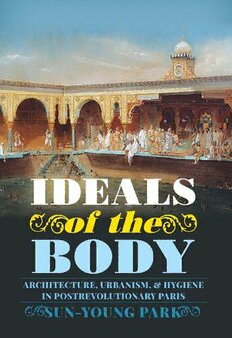
Ideals of the Body: Architecture, Urbanism, and Hygiene in Postrevolutionary Paris PDF
Preview Ideals of the Body: Architecture, Urbanism, and Hygiene in Postrevolutionary Paris
ideals of the body Culture, Politics, and the Built Environment Dianne Harris, Editor Also in the series Colonialism and Modern Architecture in Germany Itohan Osayimwese Modern Architecture in Mexico City: History, Representation, and the Shaping of a Capital Kathryn E. O’Rourke Building Modern Turkey: State, Space, and Ideology in the Early Republic Zeynep Kezer Re-Collecting Black Hawk: Landscape, Memory, and Power in the American Midwest Nicholas A. Brown and Sarah E. Kanouse Designing Tito’s Capital: Urban Planning, Modernism, and Socialism in Belgrade Brigitte Le Normand Architecture, Politics, and Identity in Divided Berlin Emily Pugh Governing by Design: Architecture, Economy, and Politics in the Twentieth Century Edited by Daniel M. Abramson, Arindam Dutta, Timothy Hyde, and Jonathan Massey for Aggregate Second Suburb: Levittown, Pennsylvania Edited by Dianne Harris Ideals ß Body of the ß Architecture, Urbanism, and Hygiene in Postrevolutionary Paris Sun-Young Park University of Pittsburgh Press This book was published with support from Furthermore: A program of the J. M. Kaplan Fund and the Department of History and Art History at George Mason University. Illustrations in this book were funded in part by the SAH/Mellon Author Awards of the Society of Architectural Historians and the Textbook and Academic Authors Association. Published by the University of Pittsburgh Press, Pittsburgh, Pa., 15260 Copyright © 2018, University of Pittsburgh Press All rights reserved Manufactured in the United States of America Printed on acid-free paper 10 9 8 7 6 5 4 3 2 1 Cataloging-in-Publication data is available from the Library of Congress ISBN 13: 978-0-8229-4528-4 Jacket art: Aimé-Henry-Edmond Sewrin-Bassompierre, The Deligny Baths in 1842. Photo credit: Scala/White Images. Courtesy of Art Resource. Jacket design by Alex Wolfe Book design by Regina Starace for my parents, Seung Lan Whang and Byung Wook Park ß Contents Acknowledgments | ix Introduction | 3 1 The Soldier: Regenerating Nation and Masculinity in the Military Gymnasium | 25 2 The Schoolboy: Forming Citizens, between the Schoolroom and the Barracks | 72 Color plates follow page | 130 3 The Demoiselle: Reconstructing Gender in the Educational Space | 143 4 The Lionne: Pursuing Health and Pleasure in Leisure Gardens | 194 5 The Sportsman: Shaping Bourgeois Bodies in Urban Recreational Grounds | 236 Epilogue. Rereading the Capital of Modernity | 294 Notes | 305 Bibliography | 335 Index | 365 Acknowledgments This book originated in the Department of Architecture and Urban Planning at Harvard University, and it could not have come into being, much less com- pletion, without the support, patience, and always-inspiring commentary of my mentors, Antoine Picon and Neil Levine. My interest in nineteenth-century France was first sparked by Antoine Picon’s lectures on Saint-Simonianism and Parisian maps in the Harvard Graduate School of Design’s Buildings, Texts, Contexts course in 2005, when I was a first-year master of architecture student. The seminar he and Neil Levine co-taught in 2006 on nineteenth-century Paris allowed me to develop this interest, through an investigation of the Second Empire sewer system. As I made my way through the fetid depths of the Parisian underworld to the more wholesome spaces examined in this book, they were an unceasing source of intellectual and moral support, and I thank them for always providing me with just the right amount of encouragement and/or skepticism to keep my work moving forward. In the course of beginning, developing, and writing this book, I have been intellectually indebted to numerous people who may or may not be aware of their influence on my work. At Harvard, I learned how to be both a scholar and a teacher through the examples set by K. Michael Hays, Alina Payne, Allan Brandt, Ann Blair, Charles Rosenberg, Erika Naginski, and Eve Blau. In Paris, Rebecca Rogers directed me to some key sources in the early stages of research, and provided detailed and incisive feedback on preliminary versions of several chapters. Gabrielle Houbre kindly welcomed me into her Genres et sociétés semi- nar in 2012, and gave me my first taste of French academic life. Annmarie Adams shared valuable insights on my project in its early draft, and in her continued, generous support, has served as a model for how I might myself assist junior scholars later on.
